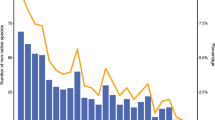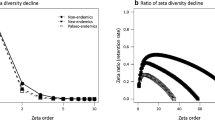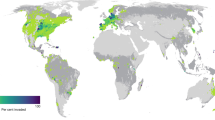Abstract
Understanding the mechanisms of biological invasion is fundamental for biodiversity conservation in the Anthropocene. This study focused on a large-scale colonization pattern of exotic seed plants, which include 1094 species characterized by different geographical origins, into the insular flora of Japan. We investigated a nation-wide pattern of species richness and phylogenetic structure (clustering/over-dispersion) of exotic and its recipient native species (4664 species). We tested the invasion hypotheses associated with environmental filtering, biological resistance of recipient assemblages, human disturbance and biogeographical origins of exotics. The exotics originated from the same (Palearctic and Indo-Malay) and adjacent (Nearctic and Oceanic) biogeographical regions were widely distributed across the country under temperate climate condition, whereas tropical exotic plants from remote regions (Afrotropic, Australasian, and Neotropical) colonized mainly the south-western parts of Japan. Exotic species richness and phylogenetic structure, especially those from the same/adjacent regions, were well explained by climatic, edaphic, and topographic factors, supporting the environmental filtering hypothesis. For all the biogeographical origins, exotic richness was positively associated with native richness, opposing the biological resistance hypothesis. Human disturbance was positively associated with exotic richness, while its relationships with the exotics’ phylogenetic structure varied according to their biogeographical origins. These findings indicate that site’s invasibility was determined by the combination of exotic’s biogeographical origins and abiotic/biotic conditions of its recipient native flora. Our results suggest that global warming may accelerate the northward expansion of tropical exotic plants while future land-use changes can promote biological invasion regardless of exotics’ origins.




Similar content being viewed by others
Data availability
Data used in the analyses is available from Zenodo (https://doi.org/10.5281/zenodo.4575297).
References
Alexander JM, Kueffer C, Daehler CC et al (2011) Assembly of nonnative floras along elevational gradients explained by directional ecological filtering. Proc Natl Acad Sci 108:656–661. https://doi.org/10.1073/pnas.1013136108
Beaury EM, Finn JT, Corbin JD et al (2019) Biotic resistance to invasion is ubiquitous across ecosystems of the United States. Ecol Lett 23:476–482. https://doi.org/10.1111/ele.13446
Bellard C, Leclerc C, Leroy B et al (2014) Vulnerability of biodiversity hotspots to global change. Glob Ecol Biogeogr 23:1376–1386. https://doi.org/10.1111/geb.12228
Bjornstad ON (2020) ncf: Spatial Covariance Functions. R package version 1.2-9. https://CRAN.R-project.org/package=ncf
Blackburn TM, Delean S, Pyšek P, Cassey P (2016) On the island biogeography of aliens: a global analysis of the richness of plant and bird species on oceanic islands. Glob Ecol Biogeogr 25:859–868. https://doi.org/10.1111/geb.12339
Buckley YM, Catford J (2016) Does the biogeographic origin of species matter? Ecological effects of native and non-native species and the use of origin to guide management. J Ecol 104:4–17. https://doi.org/10.1111/1365-2745.12501
Carboni M, Münkemüller T, Lavergne S et al (2016) What it takes to invade grassland ecosystems: traits, introduction history and filtering processes. Ecol Lett 19:219–229. https://doi.org/10.1111/ele.12556
Casado MA, Acosta-Gallo B, Sánchez-Jardón L et al (2015) Interactive effects of source and recipient habitats on plant invasions: distribution of exotic species in Chile. Divers Distrib 21:609–619. https://doi.org/10.1111/ddi.12326
Cavender-Bares J, Ackerly DD, Hobbie SE, Townsend PA (2016) Evolutionary legacy effects on ecosystems: biogeographic origins, plant traits, and implications for management in the Era of global change. Annu Rev Ecol Evol Syst 47:433–462. https://doi.org/10.1146/annurev-ecolsys-121415-032229
Chiron F, Shirley S, Kark S (2008) Human-related processes drive the richness of exotic birds in Europe. Proc R Soc B Biol Sci 276:47–53. https://doi.org/10.1098/rspb.2008.0994
Chun J-H, Lee C-B (2017) Disentangling the local-scale drivers of taxonomic, phylogenetic and functional diversity in woody plant assemblages along elevational gradients in South Korea. PLoS ONE 12:e0185763. https://doi.org/10.1371/journal.pone.0185763
Chytrý M, Jarosik V, Pysek P et al (2008) Separating habitat invasibility by alien plants from the actual level of invasion. Ecology 89:1541–1553. https://doi.org/10.1890/07-0682.1
Chytrý M, Pyšek P, Wild J et al (2009) European map of alien plant invasions based on the quantitative assessment across habitats. Divers Distrib 15:98–107. https://doi.org/10.1111/j.1472-4642.2008.00515.x
Daru BH, Holt BG, Lessard J-P et al (2017) Phylogenetic regionalization of marine plants reveals close evolutionary affinities among disjunct temperate assemblages. Biol Conserv 213:351–356. https://doi.org/10.1016/j.biocon.2016.08.022
Darwin C (1859) On the origins of species by means of natural selection. John Murray, London
Davies KF, Cavender-Bares J, Deacon N (2011) Native communities determine the identity of exotic invaders even at scales at which communities are unsaturated. Divers Distrib 17:35–42. https://doi.org/10.1111/j.1472-4642.2010.00721.x
Davies KF, Chesson P, Harrison S et al (2005) Spatial heterogeneity explains the scale dependence of the native-exotic diversity relationship. Ecology 86:1602–1610. https://doi.org/10.1890/04-1196
Davis MA, Grime JP, Thompson K, of Ecology T-K, (2000) Fluctuating resources in plant communities: a general theory of invasibility. J Ecol 88:528–534. https://doi.org/10.1046/j.1365-2745.2000.00473.x
Diez JM, Sullivan JJ, Hulme PE et al (2008) Darwin’s naturalization conundrum: dissecting taxonomic patterns of species invasions. Ecol Lett 11:674–681. https://doi.org/10.1111/j.1461-0248.2008.01178.x
El-Barougy R, MacIvor SJ, Arnillas CA et al (2020) Richness, phylogenetic diversity, and abundance all have positive effects on invader performance in an arid ecosystem. Ecosphere. https://doi.org/10.1002/ecs2.3045
Elton CS (1958) The ecology of invasions by animals and plants. Methuen, London
Escobedo VM, Rios RS, Alcayaga-Olivares Y, Gianoli E (2020) Disturbance reinforces community assembly processes differentially across spatial scales. Ann Bot. https://doi.org/10.1093/aob/mcaa162
Fick SE, Hijmans RJ (2017) WorldClim 2: new 1-km spatial resolution climate surfaces for global land areas. Int J Climatol 37:4302–4315. https://doi.org/10.1002/joc.5086
Fridley JD, Stachowicz JJ, Naeem S et al (2007) The invasion paradox: reconciling pattern and process in species invasions. Ecology 88:3–17. https://doi.org/10.1890/0012-9658(2007)88[3:TIPRPA]2.0.CO;2
Guo Q, Fei S, Shen Z et al (2018) A global analysis of elevational distribution of non-native versus native plants. J Biogeogr 45:793–803. https://doi.org/10.1111/jbi.13145
Hengl T, de Jesus JM, MacMillan RA et al (2014) SoilGrids1 km—global soil information based on automated mapping. PLoS ONE 9:e105992. https://doi.org/10.1371/journal.pone.0105992
Hulme PE (2017) Climate change and biological invasions: evidence, expectations, and response options. Biol Rev 92:1297–1313. https://doi.org/10.1111/brv.12282
Huston MA (2004) Management strategies for plant invasions: manipulating productivity, disturbance, and competition. Divers Distrib 10:167–178. https://doi.org/10.1111/j.1366-9516.2004.00083.x
Jones EI, Nuismer SL, Gomulkiewicz R (2013) Revisiting Darwin’s conundrum reveals a twist on the relationship between phylogenetic distance and invasibility. Proc Natl Acad Sci 110:20627–20632. https://doi.org/10.1073/pnas.1310247110
Kalusová V, Chytrý M, van Kleunen M et al (2017) Naturalization of European plants on other continents: the role of donor habitats. Proc Natl Acad Sci 114:13756–13761. https://doi.org/10.1073/pnas.1705487114
Kembel SW, Cowan PD, Helmus MR et al (2010) Picante: R tools for integrating phylogenies and ecology. Bioinformatics 26:1463–1464. https://doi.org/10.1093/bioinformatics/btq166
Knapp S, Kühn I, Wittig R et al (2008) Urbanization causes shifts in species’ trait state frequencies. Preslia 80:375–388
Kreft H, Jetz W (2010) A framework for delineating biogeographical regions based on species distributions. J Biogeogr 37:2029–2053. https://doi.org/10.1111/j.1365-2699.2010.02375.x
Kubota Y, Kusumoto B, Shiono T, Tanaka T (2017) Phylogenetic properties of Tertiary relict flora in the east Asian continental islands: imprint of climatic niche conservatism and in situ diversification. Ecography (Cop) 40:436–447. https://doi.org/10.1111/ecog.02033
Kubota Y, Shiono T, Kusumoto B (2015) Role of climate and geohistorical factors in driving plant richness patterns and endemicity on the east Asian continental islands. Ecography (Cop) 38:639–648. https://doi.org/10.1111/ecog.00981
Kusumoto B, Shiono T, Konoshima M et al (2017) How well are biodiversity drivers reflected in protected areas? A representativeness assessment of the geohistorical gradients that shaped endemic flora in Japan. Ecol Res 32:299–311. https://doi.org/10.1007/s11284-017-1451-6
Kusumoto B, Villalobos F, Shiono T, Kubota Y (2019a) Reconciling Darwin’s naturalization and pre-adaptation hypotheses: an inference from phylogenetic fields of exotic plants in Japan. J Biogeogr. https://doi.org/10.1111/jbi.13683
Kusumoto B, Shiono T, Kubota Y (2019b) Input data of phylogenetic field analysis for exotic seed plants in Japan. In: Zenodo
Lefcheck JS (2016) PIECEWISESEM: Piecewise structural equation modelling in R for ecology, evolution, and systematics. Methods Ecol Evol 7:573–579. https://doi.org/10.1111/2041-210X.12512
Lehtomäki J, Kusumoto B, Shiono T et al (2018) Spatial conservation prioritization for the East Asian islands: a balanced representation of multitaxon biogeography in a protected area network. Divers Distrib. https://doi.org/10.1111/ddi.12869
Lonsdale WM (1999) Global patterns of plant invasions and the concept of invasibility. Ecology 80:1522–1536. https://doi.org/10.1890/0012-9658(1999)080[1522:GPOPIA]2.0.CO;2
Lososová Z, Bello F, Chytrý M et al (2015) Alien plants invade more phylogenetically clustered community types and cause even stronger clustering. Glob Ecol Biogeogr 24:786–794. https://doi.org/10.1111/geb.12317
Lundholm JT, Richardson PJ (2010) Habitat analogues for reconciliation ecology in urban and industrial environments: Habitat analogues. J Appl Ecol 47:966–975. https://doi.org/10.1111/j.1365-2664.2010.01857.x
Marini L, Battisti A, Bona E et al (2012) Alien and native plant life-forms respond differently to human and climate pressures. Glob Ecol Biogeogr 21:534–544. https://doi.org/10.1111/j.1466-8238.2011.00702.x
Marini L, Gaston KJ, Prosser F, Hulme PE (2009) Contrasting response of native and alien plant species richness to environmental energy and human impact along alpine elevation gradients. Glob Ecol Biogeogr 18:652–661. https://doi.org/10.1111/j.1466-8238.2009.00484.x
Maurel N, Hanspach J, Kühn I et al (2016) Introduction bias affects relationships between the characteristics of ornamental alien plants and their naturalization success. Glob Ecol Biogeogr 25:1500–1509. https://doi.org/10.1111/geb.12520
Melbourne BA, Cornell HV, Davies KF et al (2007) Invasion in a heterogeneous world: resistance, coexistence or hostile takeover? Ecol Let 10:77–94. https://doi.org/10.1111/j.1461-0248.2006.00987.x
Miller ET, Farine DR, Trisos CH (2017) Phylogenetic community structure metrics and null models: a review with new methods and software. Ecography 40:461–477. https://doi.org/10.1111/ecog.02070
Mitchell CE, Agrawal AA, Bever JD et al (2006) Biotic interactions and plant invasions. Ecol Lett 9:726–740. https://doi.org/10.1111/j.1461-0248.2006.00908.x
Mittermeier RA, Turner WR, Larsen FW et al (2011) Global biodiversity conservation: the critical role of hotspots. Biodiversity hotspots. Springer, Berlin, pp 3–22
Mod HK, Chevalier M, Luoto M, Guisan A (2020) Scale-dependence of ecological assembly rules: insights from empirical datasets and joint species distribution modelling. J Ecol. https://doi.org/10.1111/1365-2745.13434
Moffatt SF, McLachlan SM (2004) Understorey indicators of disturbance for riparian forests along an urban–rural gradient in Manitoba. Ecol Indic 4:1–16. https://doi.org/10.1016/j.ecolind.2003.08.002
Nordheimer R, Jeschke JM (2018) Disturbance hypothesis. Invasion biology: hypotheses and evidence. CABI, Boston, pp 71–78
Nunez-Mir GC, Liebhold AM, Guo Q et al (2017) Biotic resistance to exotic invasions: its role in forest ecosystems, confounding artifacts, and future directions. Biol Invasions 19:3287–3299. https://doi.org/10.1007/s10530-017-1413-5
Oksanen J, Blanchet FG, Friendly M et al (2017) vegan: Community Ecology Package. R package version 2.5-6.
Olson DM, Dinerstein E, Wikramanayake ED et al (2001) Terrestrial Ecoregions of the World: a new map of life on earth: a new global map of terrestrial ecoregions provides an innovative tool for conserving biodiversity. Bioscience 51:933–938. https://doi.org/10.1641/0006-3568(2001)051[0933:TEOTWA]2.0.CO;2
Parker JD (2006) Opposing effects of native and exotic herbivores on plant invasions. Science (80-) 311:1459–1461. https://doi.org/10.1126/science.1121407
Pearson DE, Ortega YK, Eren Ö, Hierro JL (2018) Community assembly theory as a framework for biological invasions. Trends Ecol Evol 33:313–325. https://doi.org/10.1016/j.tree.2018.03.002
Powell KI, Chase JM, Knight TM (2013) Invasive plants have scale-dependent effects on diversity by altering species-area relationships. Science 339:316–318. https://doi.org/10.1126/science.1226817
Pyšek P, Dawson W, Essl F et al (2019) Contrasting patterns of naturalized plant richness in the Americas: Numbers are higher in the North but expected to rise sharply in the South. Glob Ecol Biogeogr 28:779–783. https://doi.org/10.1111/geb.12891
Pysek P, Jarosik V, Hulme PE et al (2010) Disentangling the role of environmental and human pressures on biological invasions across Europe. Proc Natl Acad Sci 107:12157–12162. https://doi.org/10.1073/pnas.1002314107
Pyšek P, Jarošík V, Pergl J et al (2009) The global invasion success of Central European plants is related to distribution characteristics in their native range and species traits. Divers Distrib 15:891–903. https://doi.org/10.1111/j.1472-4642.2009.00602.x
Pyšek P, Richardson DM (2006) The biogeography of naturalization in alien plants. J Biogeogr 33:2040–2050. https://doi.org/10.1111/j.1365-2699.2006.01578.x
Qian H, Sandel B (2017) Phylogenetic relatedness of native and exotic plants along climate gradients in California, USA. Divers Distrib 23:1323–1333. https://doi.org/10.1111/ddi.12620
R Core Team (2019) R: A language and environment for statistical computing
Ronk A, Szava-Kovats R, Zobel M, Pärtel M (2017) Observed and dark diversity of alien plant species in Europe: estimating future invasion risk. Biodivers Conserv 26:899–916. https://doi.org/10.1007/s10531-016-1278-4
Sanderson EW, Jaiteh M, Levy MA (2002) The human footprint and the last of the wild. Bioscience 52:891–904. https://doi.org/10.1641/0006-3568(2002)052[0891:THFATL]2.0.CO;2
Shiono T, Kusumoto B, Yasuhara M, Kubota Y (2018) Roles of climate niche conservatism and range dynamics in woody plant diversity patterns through the Cenozoic. Glob Ecol Biogeogr 27:865–874. https://doi.org/10.1111/geb.12755
Shipley B (2000) A new inferential test for path models based on directed acyclic graphs. Struct Equ Model A Multidiscip J 7:206–218. https://doi.org/10.1207/S15328007SEM0702_4
Silvertown J, McConway K, Gowing D et al (2006) Absence of phylogenetic signal in the niche structure of meadow plant communities. Proc R Soc B 273:39–44. https://doi.org/10.1098/rspb.2005.3288
Swenson NG (2009) Phylogenetic resolution and quantifying the phylogenetic diversity and dispersion of communities. PloSONE 4:e4390. https://doi.org/10.1371/journal.pone.0004390
Tayleur CM, Devictor V, Gaüzère P et al (2016) Regional variation in climate change winners and losers highlights the rapid loss of cold-dwelling species. Divers Distrib 22:468–480. https://doi.org/10.1111/ddi.12412
Thuiller W, Richardson DM, Pysek P et al (2005) Niche-based modelling as a tool for predicting the risk of alien plant invasions at a global scale. Glob Chang Biol 11:2234–2250. https://doi.org/10.1111/j.1365-2486.2005.001018.x
Ulrich W, Kubota Y, Kusumoto B et al (2018) Species richness correlates of raw and standardized co-occurrence metrics. Glob Ecol Biogeogr 27:395–399. https://doi.org/10.1111/geb.12711
Vilà M, Espinar JL, Hejda M et al (2011) Ecological impacts of invasive alien plants: a meta-analysis of their effects on species, communities and ecosystems. Ecol Lett 14:702–708. https://doi.org/10.1111/j.1461-0248.2011.01628.x
Webb CO (2000) Exploring the phylogenetic structure of ecological communities: an ex- ample for rain forest trees. Am Nat 156:145–155. https://doi.org/10.1086/303378
Webb CO, Ackerly DD, McPeek MA, Donoghue MJ (2002) Phylogenies and community ecology. Annu Rev Ecol Syst 33:475–505. https://doi.org/10.1146/annurev.ecolsys.33.010802.150448
Wilson JRU, Dormontt EE, Prentis PJ et al (2009) Something in the way you move: dispersal pathways affect invasion success. Trends Ecol Evol 24:136–144. https://doi.org/10.1016/j.tree.2008.10.007
Yonekura K, Kajita T (2003) BG Plants–index for Japanese-scientific plant names (Ylist). http://ylist.info/. Accessed 28 Nov 2018
Zanne AE, Tank DC, Cornwell WK et al (2014) Three keys to the radiation of angiosperms into freezing environments. Nature 506:89–92. https://doi.org/10.1038/nature12872
Zefferman E, Stevens JT, Charles GK et al (2015) Plant communities in harsh sites are less invaded: a summary of observations and proposed explanations. AoB Plants. https://doi.org/10.1093/aobpla/plv056
Acknowledgements
We are grateful to members of the data management team of Kubota-lab, the University of the Ryukyus, for their support with digitization.
Funding
Financial support was provided by the Environment Research and Technology Development Fund (4-1501 and 4-1802) of the Ministry of the Environment, Japan, and the Japan Society for the Promotion of Science (no17H00806). This study was also supported by the Program for Advancing Strategic International Networks to Accelerate the Circulation of Talented Researchers, the Japan Society for the Promotion of Science.
Author information
Authors and Affiliations
Corresponding author
Ethics declarations
Conflict of interest
The authors declare that they have no conflicts of interest.
Additional information
Publisher's Note
Springer Nature remains neutral with regard to jurisdictional claims in published maps and institutional affiliations.
Supplementary Information
Below is the link to the electronic supplementary material.
Rights and permissions
About this article
Cite this article
Kusumoto, B., Kubota, Y., Shiono, T. et al. Biogeographical origin effects on exotic plants colonization in the insular flora of Japan. Biol Invasions 23, 2973–2984 (2021). https://doi.org/10.1007/s10530-021-02550-3
Received:
Accepted:
Published:
Issue Date:
DOI: https://doi.org/10.1007/s10530-021-02550-3




